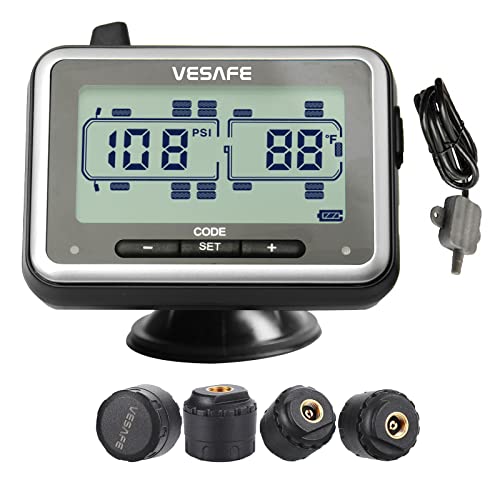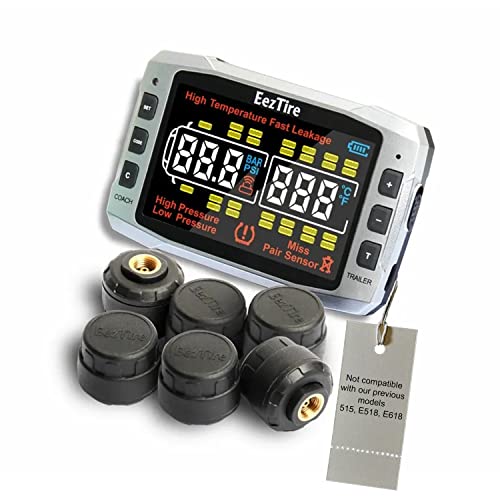Get ready to revolutionize your driving experience with the 7 best aftermarket tire pressure monitoring systems (TPMS) on the market. These innovative systems are designed to keep you safe, enhance performance, and provide peace of mind on every journey.
With user-friendly interfaces and advanced features, these TPMS options ensure that your tires are always in optimal condition, and ready to tackle any road conditions.
There is a TPMS system suitable for every type of driver, including those who drive a trailer, travel off-road, or commute every day. Considering these 7 best aftermarket TPMS options, you can solve tire pressure issues and hello to a smoother, safer ride.
Our Top 3 Picks of the Best Aftermarket TPMS
What is tire pressure monitoring system (TPMS)?
A Tire Pressure Monitoring System (TPMS) is a safety feature in a vehicle that monitors tire air pressure. It alerts drivers when pressure is low, preventing blowout, poor fuel efficiency, and unusual tire wear hazards. TPMS is either direct (via sensors in each tire) or indirect (via wheel speed sensors). TPMS offers safety, improved vehicle performance, and guarantees the tires are always in top condition.
Why Upgrade to Aftermarket TPMS?
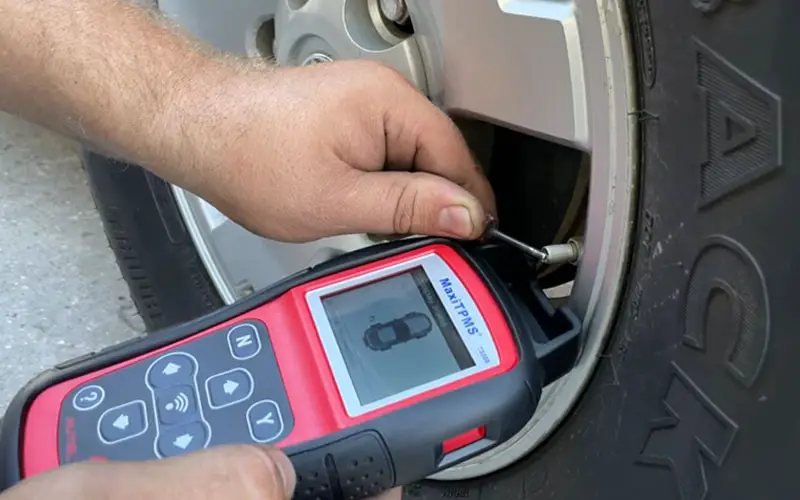
Upgrading to aftermarket Tire Pressure Monitoring Systems (TPMS) can offer several benefits for vehicle owners. TPMS is a safety feature designed to monitor the air pressure in a vehicle’s tires and alert the driver when there is a significant drop in pressure. Here are 7 reasons why upgrading to aftermarket TPMS might be advantageous:
- Enhanced Safety: Maintaining proper tire pressure is crucial for vehicle safety. Adequate tire pressure ensures optimal traction, handling, and braking performance. Aftermarket TPMS can provide more accurate and timely alerts, reducing the risk of accidents caused by under-inflated or over-inflated tires.
- Compatibility with Older Vehicles: Some vehicles may not come equipped with a TPMS system, especially older models. Aftermarket TPMS offers a solution for owners of these vehicles to add a safety feature that has become increasingly standard in newer cars.
- Customization and Advanced Features: Aftermarket TPMS systems often come with additional features not found in factory-installed systems. These may include real-time pressure and temperature monitoring, customizable pressure thresholds, and smartphone connectivity, allowing drivers to monitor tire conditions remotely.
- Cost-Effective Solutions: Factory-installed TPMS systems can be expensive to repair or replace. Aftermarket options provide cost-effective alternatives, often with similar or improved functionality. This can be particularly beneficial for older vehicles or those out of warranty.
- Easy Installation: Aftermarket TPMS systems are designed for relatively easy installation, and many models can be installed without professional assistance. This makes it a convenient option for vehicle owners looking to enhance their safety without significant installation costs.
- Compatibility with Aftermarket Wheels and Tires: Upgrading to aftermarket wheels or tires may result in compatibility issues with factory TPMS sensors. Aftermarket TPMS sensors can be selected to match the specific requirements of aftermarket components, ensuring seamless integration.
- User-Friendly Display: Aftermarket TPMS systems often feature user-friendly displays, providing clear and easily understandable information about tire pressure and temperature. This can contribute to a better overall driving experience.
Are Aftermarket TPMS Systems Compatible with All Vehicles?
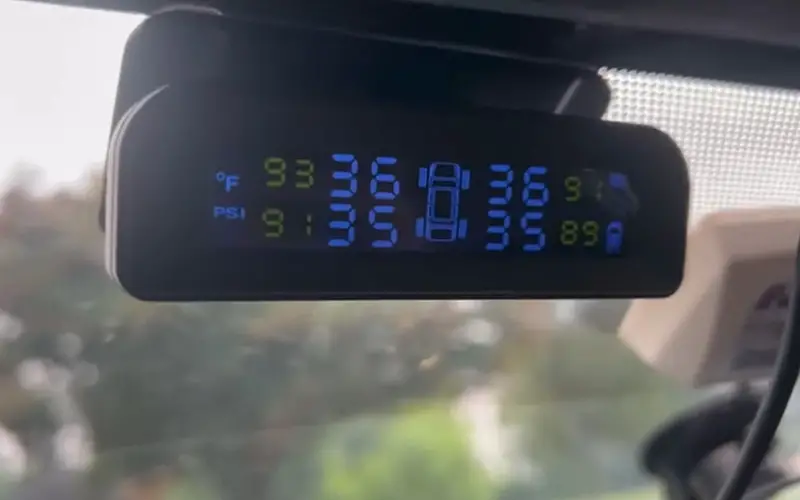
Aftermarket TPMS (Tire Pressure Monitoring System) are designed to be compatible with a wide range of vehicles, but there can be variations depending on the specific system and the vehicle’s make and model.
Generally, most aftermarket TPMS systems are universal and can be installed on various types of cars, trucks, and SUVs. They typically come with a set of sensors that can be fitted to the valve stems of the tires, and a display unit that can be mounted inside the vehicle. These systems are often programmable to accommodate different tire sizes and pressure ranges.
However, there are a few factors to consider:
- Frequency: TPMS systems operate on different frequencies (e.g., 315 MHz or 433 MHz). It’s crucial to choose a system that matches the frequency requirements of your vehicle.
- Sensor Compatibility: Some vehicles may have specific requirements or proprietary TPMS sensors. Ensure that the aftermarket system you choose is compatible with the sensors required by your vehicle.
- Programming: Certain TPMS systems may require programming or configuration to work correctly with your vehicle. Make sure the system you choose can be easily programmed to meet your vehicle’s specifications.
- Compatibility with OEM Systems: If your vehicle already has a factory-installed TPMS, check if the aftermarket system is compatible or if it can work alongside the existing system without interference.
7 Best Aftermarket Tire Pressure Monitoring Systems – Review
Revolutionize your driving experience with the latest aftermarket Tire Pressure Monitoring Systems (TPMS) that guarantee enhanced safety, performance, and peace of mind on the road. In this review, we take the top 7 best aftermarket TPMS available on the market, each carefully chosen for its reliability, ease of use, and advanced features.
1. Tymate RV M7-3 Tire Pressure Monitoring System – TPMS
The Tymate RV Tire Pressure Monitoring System – M7-3 TPMS is a game-changer for road safety, delivering a robust set of features to keep your tires in check. Boasting an incredibly light 9.6-ounce build with compact dimensions (6.3 x 4.72 x 1.97 inches), this system is a breeze to install.
What sets the M7-3 apart is its five types of alarms and customizable alarm values. From fast leaks to high/low-pressure, high-temperature, and low sensor voltage, it covers all bases. The system’s sensors are power-efficient, offering a lengthy battery life of up to two years, and they’re accurate with a small acceptable tire pressure error of about 3psi.
The M7-3 goes beyond the ordinary with multiple charging methods – solar, USB, and cigarette lighter options, ensuring you’re never stranded with a dead battery. The smart screen adjusts the backlight and changes color dynamically based on conditions, enhancing readability.
With a focus on power-saving, the M7-3 features an auto-sleep mode and a convenient switch button, striking a balance between functionality and durability.
Tymate’s commitment to tire safety shines through in this TPMS. Their emphasis on R&D, production quality, and brand integrity is evident. The easy setup and pre-programming make it user-friendly, while the comprehensive user guide ensures a smooth experience.
In the crowded TPMS market, Tymate stands out as a reliable choice, combining innovation, durability, and user-friendliness. Keep your tires in top shape and hit the road with confidence using the Tymate RV Tire Pressure Monitoring System – M7-3 TPMS.
Pros:
- User-friendly with easy setup.
- Five alarm modes for comprehensive monitoring.
- Long-lasting sensor batteries.
- Multiple charging options including solar.
- Smart screen adjusts for optimal visibility.
Cons:
- Limited to tracking gradual pressure changes.
- Sensor interference may occur in some situations.
2. Tymate RV M12-3 Tire Pressure Monitor System
The Tymate RV Tire Pressure Monitoring System – M12-3 is best for road safety, earning its place as an essential companion for drivers. Weighing just 12 ounces and measuring 6.3 x 4.72 x 1.97 inches, it’s compact yet packs a punch in features.
The standout feature is its auto solar charge capability, ensuring continuous functionality with solar lithium battery panels, backed up by AC/DC charging options. The five-alarm modes (high/low pressure, high temperature, rapid air leakage, sensor low battery) provide real-time alerts for proactive driving safety.
Auto-adjustable backlight, sleep & awake modes, and tire position exchange functionality enhance user convenience. The low power consumption and long-lasting sensors (up to 2 years) are small, lightweight, and accurate, with an error range of approximately 3psi.
Tymate’s commitment to tire safety shines through its comprehensive product description, emphasizing ease of use and troubleshooting tips. The brand’s dedication to integrity, quality, and customer satisfaction positions it as a reliable TPMS supplier worldwide.
In summary, the Tymate M12-3 stands out for its innovative features, user-friendly design, and Tymate’s commitment to tire safety, making it a must-have for every driver.
Pros:
- Auto solar charge ensures continuous functionality.
- Five alarm modes for real-time tire condition alerts.
- Auto-adjustable backlight and sleep mode save energy.
- Long-lasting sensors with easy tire position exchange.
Cons:
- Limited to slow changes; may not detect instant tire abnormalities.
- Requires careful installation sequence to avoid potential display issues.
- Possible signal interference; may need a repeater in some cases.
3. TST 507 Tire Pressure Monitoring System with 6 Flow Thru Sensors
The TST 507 Tire Pressure Monitoring System is awesome for any vehicle owner, offering real-time monitoring on a 3.5″ color display. This compact system, measuring 3.25 x 2 x 8.5 inches and weighing only 2 pounds, ensures you’re always informed about tire pressure and temperature.
The monitor provides visual, audible, and textual alerts for unsafe conditions, reporting in PSI, BAR, F°, and C°. With user-adjustable high and low-pressure alarms, it caters to your specific needs.
Versatility is a highlight with the TST 507, accommodating various vehicles, from two vehicles to RVs and trailers. The system monitors up to 110 tires, making it suitable for a wide range of applications.
The flow-thru design of the sensors allows for easy tire pressure adjustment without sensor removal. These compact and water-resistant sensors also feature an anti-theft function for added security.
Installation is a breeze with the included kit featuring a wide-screen color display, six flow-thru sensors, a repeater, installation wrenches, rubber and suction cup mounts, a USB charging cable, and a 12V charging adapter.
With a 3-year warranty and a 30-day return policy, the TST 507 ensures peace of mind on the road. Experience top-notch customer service and support from the most trusted TPMS brand, enhancing safety, reducing risks of blowouts, and even improving fuel efficiency.
Pros:
- Real-time monitoring for safer driving.
- Versatile, fits various vehicles.
- Flow-thru design allows easy pressure adjustment.
- Compact, water-resistant sensors with anti-theft features.
- Easy installation with comprehensive kit.
Cons:
- Cost may be higher compared to basic models.
- Display may be small for some users.
4. TireMinder i10 RV TPMS with 4 Transmitters
The TireMinder i10 RV TPMS with 4 Transmitters is excellent for road safety, ensuring peace of mind during your travels. Weighing just 1.81 pounds, this compact device boasts dimensions of 0.75 x 4.15 x 4 inches and comes with 8 Lithium Metal batteries, providing hassle-free operation.
With the ability to monitor up to 20 tires across four different vehicles simultaneously, this TPMS delivers real-time data on a vibrant color display. The package includes a Rhino Signal Booster for extended range, making it suitable for various RV setups within 100 feet and fewer than 20 tires.
The TireMinder i10 stands out with its constant tire monitoring, displaying accurate readings (+/- 1 PSI from 0-199 PSI) whether you’re driving or stationary.
The user-friendly design, high-powered signal booster, and exceptional accuracy make it a must-have for RV enthusiasts. Backed by a 3-year warranty and lifetime USA-based customer support, the TireMinder i10 ensures a worry-free journey.
Pros:
- Constant tire monitoring for enhanced safety.
- Easy-to-read color display.
- Compatible with multiple vehicles.
- Includes Rhino Signal Booster for extended range.
- Lifetime USA-based customer support.
Cons:
- Initial setup may take time for some users.
5. VESAFE TPMS, Wireless Tire Pressure Monitoring System
The VESAFE TPMS Wireless Tire Pressure Monitoring System is fantastic for safe and worry-free driving. Weighing just 1.43 pounds, this compact device ensures your peace of mind on the road. With dimensions of 6.77 x 3.78 x 7.91 inches, it’s a convenient addition to your vehicle.
Equipped with 5 alarm modes, including high/low tire pressure, temperature, tire leakage, and battery life, VESAFE TPMS keeps a vigilant eye on up to 17 tires. The adjustable alert values and accurate real-time data display on a large screen make it user-friendly.
The system’s low power consumption allows driving up to 5,000 miles on a full charge, and the durable, anti-theft sensors boast a remarkable 2-year battery life.
The automatic connection and sleep mode, along with professional support from VESAFE, enhance its functionality. Installation is hassle-free, and the monitor can be placed on the windshield or dashboard for easy visibility.
With alerts for high pressure, low pressure, high temperature, and rapid leaks, this TPMS ensures a smooth and safe journey. The waterproof, dust-proof sensors guarantee durability, making VESAFE TPMS a must-have for every vehicle owner.
Pros:
- Easy installation and user-friendly interface.
- Accurate real-time data display with adjustable alert values.
- Long-lasting battery life and low power consumption.
- Anti-theft sensors for added security.
Cons:
- Limited signal range may require a signal booster for larger vehicles.
- Need to keep the monitor away from other electronic devices for optimal performance.
6. EEZTire-TPMS Pro (518C) Tire Pressure and Temperature Monitoring System
The EEZTire-TPMS Pro (518C) is the best in tire pressure monitoring for RVs, setting the industry standard since 2005. This modern system offers real-time safety and boosts fuel economy by accurately tracking pressure and temperature for up to 26 tires, handling pressures of up to 210 psi.
The motion-sensitive monitor operates 24/7, with alerts at 6-second intervals. Cleverly, it enters power-saving mode after 15 minutes of no motion, preserving the rechargeable battery.
Configurable high-temperature alarms and separate controls for RV and trailer sensors enhance flexibility. Installation is a breeze, earning praise for its simplicity and reliability. Setup takes minutes, and the monitor’s rechargeable lithium battery lasts up to 60 hours on a single charge.
The replaceable sensor battery ensures long-term use. EEZ RV Products stands by its creation with a 1-year limited warranty, backed by excellent customer support. The 3.5” color display provides clear information, and the option to add a booster for signal enhancement is a thoughtful touch.
Drive with confidence, as this TPMS system gives 24/7 peace of mind, warning drivers before tire issues become hazardous. Upgrade your RV safety with the EEZTire-TPMS Pro, a trustworthy companion on every journey.
Pros:
- Real-time tire pressure and temperature monitoring.
- Motion-sensitive monitor with configurable alarms.
- Easy setup and operation, praised for reliability.
- Separate controls for RV and trailer sensors.
Cons:
- Booster for signal enhancement is not included.
- Requires periodic sensor battery replacement.
- Initial cost may be a consideration for some buyers.
7. TireMinder i10 RV TPMS with 10 Transmitters
The TireMinder i10 RV TPMS with 10 Transmitters is incredible for anyone looking to keep a close eye on their vehicle’s tires. With the ability to monitor up to 20 tires across four different vehicles, this TPMS ensures your safety on the road.
The color display, the always-on feature, and the ability to show 10 tires at once make it user-friendly and efficient. One standout feature is the automatic swapping between front and rear vehicles, allowing you to effortlessly keep track of all tires without pressing a button.
The inclusion of a high-powered Rhino Signal Booster ensures maximum signal reliability, even in challenging conditions. Whether you’re driving or stationary, the TireMinder i10 works tirelessly, providing accurate tire information with a variance of just +/- 1 PSI from 0-199 PSI.
Setting up is a breeze, thanks to the comprehensive package that includes everything you need. The monitor, transmitters, signal booster, batteries, O-rings, anti-theft locking nuts, and a wrench – it’s all there.
With a focus on user convenience and safety, the TireMinder i10 RV TPMS is a must-have for RV owners. Stay informed, stay safe, and enjoy the road with this reliable tire monitoring system.
Pros:
- Automatic swapping between front and rear vehicles.
- High-powered Rhino Signal Booster included.
- Accurate tire monitoring while driving or stationary.
- Lifetime, USA-based customer support.
Cons:
- Some users may find the setup process challenging.
- Price may be a bit high for budget-conscious buyers.
Buying Guide for Aftermarket Tire Pressure Monitoring Systems
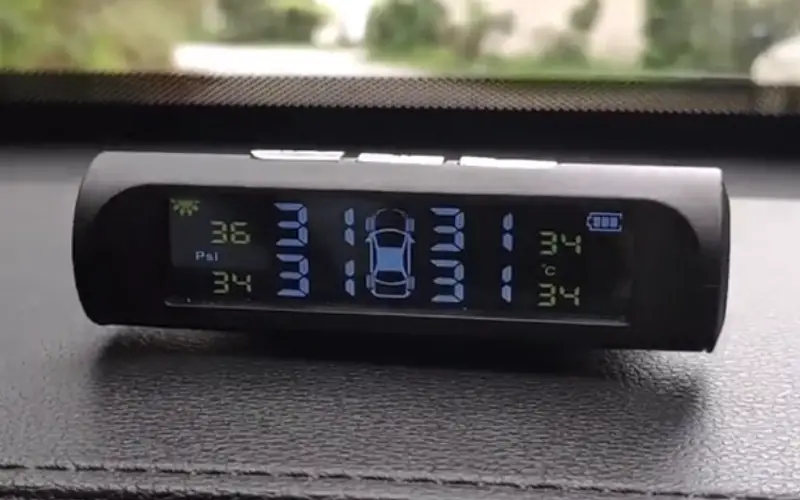
Ensuring your vehicle’s tires are properly inflated is crucial for both safety and optimal performance. While many newer cars come equipped with built-in Tire Pressure Monitoring Systems (TPMS), older vehicles may not have this feature. Fortunately, aftermarket TPMS solutions are readily available, allowing you to upgrade your car’s safety features.
In this buying guide, we’ll walk you through the key factors to consider when choosing an aftermarket TPMS to keep your tires in top condition.
Compatibility
When diving into the world of aftermarket TPMS, the first consideration is compatibility. Ensure that the system you choose is compatible with your vehicle’s make and model. Some TPMS kits are universal, while others are specifically designed for certain brands or types of vehicles. Check the product specifications or consult with the manufacturer to guarantee a seamless integration with your car.
Sensor Types
Aftermarket TPMS systems generally come with two types of sensors – internal and external. Internal sensors replace the valve stems on your tires, while external sensors attach to the tire’s valve stem. Internal sensors offer a sleeker look, as they are hidden within the tire, but they may require professional installation. External sensors are easier to install, but are visible on the valve stems. Choose the sensor type that aligns with your preferences and installation capabilities.
Ease of Installation
Look for a TPMS kit that is user-friendly and comes with clear installation instructions. Most aftermarket systems are designed for DIY installation, eliminating the need for professional assistance. Quick and easy installation not only saves you time but also ensures accurate and reliable tire pressure monitoring from the get-go.
Display and Alerts
The display unit is where you receive real-time information about your tire pressure. Opt for a system with a user-friendly and easily readable display. Some TPMS models offer digital displays, while others provide visual and audible alerts. Choose a system that suits your preference and provides clear and immediate alerts in case of low tire pressure or other issues.
Accuracy and Precision
The primary purpose of a TPMS is to provide accurate and reliable tire pressure readings. Look for a system that offers precise measurements within a reasonable margin of error. High-quality sensors and advanced technology contribute to more accurate readings, ensuring you receive timely alerts and can take appropriate action to maintain optimal tire pressure.
Battery Life
Both internal and external sensors are equipped with batteries, and their lifespan varies. Check the expected battery life of the sensors, and opt for a TPMS with longer-lasting batteries to minimize the frequency of replacements. Some advanced models come with sensors that are easily replaceable, extending the overall lifespan of the TPMS.
Monitoring Range
Consider the monitoring range of the TPMS, which refers to the maximum distance between the sensors and the display unit. A broader range ensures that the system remains effective even in larger vehicles, such as RVs or trucks. Evaluate your specific needs and choose a TPMS with an appropriate monitoring range for your vehicle.
User-Friendly Features
Look for additional features that enhance user convenience. Some TPMS models offer smartphone connectivity, allowing you to receive tire pressure alerts directly on your phone. Others may provide customizable pressure thresholds or automatic adjustments for temperature changes. Choose a system that aligns with your preferences and lifestyle for a more user-friendly experience.
Durability and Weather Resistance
Since TPMS sensors are exposed to the elements, it’s crucial to choose a system that is durable and weather-resistant. Ensure that the sensors can withstand various weather conditions, including rain, snow, and extreme temperatures. A robust and weather-resistant TPMS contributes to its longevity and reliability.
Cost and Warranty
Compare the cost of different TPMS options and consider the value they offer. While it’s essential to stay within your budget, prioritize the features that align with your requirements. Additionally, check the warranty offered by the manufacturer. A longer warranty period indicates the manufacturer’s confidence in the product’s durability and performance.
FAQs Aftermarket TPMS
Aftermarket TPMS (Tire Pressure Monitoring Systems) can be reliable. They effectively alert you when tire pressure is low, enhancing safety and fuel efficiency. However, quality varies among brands, so it’s crucial to choose a reputable one for accurate readings.
You can add a TPMS (Tire Pressure Monitoring System) aftermarket. After purchasing a compatible kit, install it by following the provided instructions. This system monitors tire pressure, enhancing safety by alerting drivers to low-pressure situations.
TPMS will function with aftermarket wheels. The Tire Pressure Monitoring System (TPMS) is compatible with non-original rims. It works by monitoring tire pressure, regardless of the wheel’s origin. Aftermarket wheels won’t hinder TPMS performance; it’ll keep alerting you if there’s any drop in tire pressure.
There are privacy concerns with wireless TPMS technology. The system collects and transmits data about your vehicle’s tire pressure, which could potentially be intercepted by unauthorized parties. This information may be exploited for tracking or other malicious purposes. It’s crucial to be mindful of the potential risks and take steps to secure your TPMS data to protect your privacy on the road.
The best aftermarket TPMS varies by your requirements but is best expressed by the Tymate RV M7-3 as a highly reputable choice for being reliable, highly compatible, and easy to install. It has universal application in most vehicles and does not need programming. TST 507 TPMS comes in second for its universal design and battery lifespan. Both feature precise pressure accuracy and long service life, offering the best among aftermarket TPMS solutions.
To reset the Tire Pressure Monitoring System (TPMS), follow these general steps:
Check Tire Pressure: Ensure all tires are inflated to the recommended PSI (found in the owner’s manual or driver’s door sticker).
Turn Ignition On: Switch the ignition to the “on” position without starting the engine.
Locate Reset Button: Find the TPMS reset button (often under the steering wheel or in the glove box).
Press and Hold: Hold the button until the TPMS light blinks or a confirmation message appears.
Drive: Drive for about 10 minutes to allow the system to recalibrate.
A Tire Pressure Monitoring System (TPMS) relies on periodic checks of the air pressure of a car’s tires. Both direct and indirect systems are found. The direct TPMS incorporates sensors installed within the individual tires, which read pressure and communicate in real-time to a vehicle’s computer by radio waves. Whenever pressure dips below a specific threshold, the driver is signaled by a warning indicator. Indirect TPMS employs anti-lock braking system (ABS) wheel speed sensors to track pressure variation by comparing tire rotation rates. Underinflated tires will rotate faster, triggering an alarm. Both types are safety-, fuel-, and tire-life-enhancing.
To turn off the Tire Pressure Monitoring System (TPMS), consult your vehicle’s owner’s manual, as methods vary by model. Some vehicles allow you to disable TPMS via the dashboard settings or infotainment system. However, disabling TPMS is not recommended, as it ensures safe tire pressure levels. If the warning light is on, check and adjust tire pressure instead. Tampering with TPMS may also violate local regulations.
To check your tire pressure monitoring system (TPMS), start by locating the TPMS reset button, typically below the steering column. Turn the ignition on but not the engine, and press and hold the button for several seconds until the TPMS light blinks three times. Let go of the button and keep on starting the vehicle, allowing the system to reset. Physically check each tire’s pressure with a tire pressure gauge to bring it to the recommended PSI.
TPMS is generally accurate, with most systems registering within ±1-2 psi of the tire’s actual pressure. Accuracy may, however, be relative to the type of TPMS (direct or indirect), sensor quality, and ambient temperature. Calibration and maintenance are required to ensure continued reliability. TPMS is a valuable aid, but it is still a good idea to physically check tire pressure every now and then for optimum safety and performance.
TPMS (Tire Pressure Monitoring System) sensors are not universal. They vary by vehicle make, model, and year due to differences in frequencies, protocols, and mounting styles. Some sensors are OEM-specific, while aftermarket options may work across multiple vehicles.
To identify a bad TPMS sensor, use a TPMS diagnostic tool to scan each sensor’s signal. A non-responsive or inconsistent signal indicates a faulty sensor. Alternatively, monitor the tire pressure display; if one tire consistently shows incorrect pressure or no data, its sensor may be bad. Physical inspection for damage or corrosion on the sensor can also help. Lastly, check for TPMS warning lights or error codes on the dashboard.
Your TPMS light can be on despite good tires due to a faulty sensor, a dead sensor battery, or a system malfunction. Temperature changes can also cause false readings. New tire rotations or replacements without resetting the TPMS can also have the light stay illuminated. Check your tire pressure manually and consult your car manual or a mechanic to diagnose and reset the system.
TPMS batteries typically last 5 to 10 years, depending on use, sensor quality, and exposure. Heavy driving, extreme heat, and sensor type (direct or indirect) can all impact battery life. When the battery is depleted, the entire sensor typically must be replaced, since most are hermetic units.
A blinking TPMS (Tire Pressure Monitoring System) light typically indicates a system malfunction rather than low tire pressure. This could be due to a faulty sensor, a system error, or issues with the TPMS module. When the light blinks, it’s important to have the system checked by a professional to diagnose and resolve the issue. That ensures your vehicle’s tire pressure monitoring functions correctly for safety.
New tires do not generally come with TPMS (Tire Pressure Monitoring System) sensors unless specified by the seller or as a part of a tire and wheel assembly. TPMS sensors are normally regarded as being part of the vehicle’s wheel assembly, not the tire. When purchasing new tires, old sensors can be reused or you can purchase replacement sensors separately when needed.
Wrapping Up!
In wrapping up our exploration of the 7 best aftermarket tire pressure monitoring systems (TPMS), it’s clear that these devices are indispensable for enhancing safety and performance on the road.
Whether you’re a daily commuter, off-road adventurer, or towing a trailer, these TPMS options offer a technological edge, ease of use, and reliable tire monitoring.
Equip your vehicle with confidence using M7-3 TPMS’s user-friendly displays and TST 507 Technologies’ tailored solutions for trailers. Minder Research’s comprehensive monitoring, Vesafe’s wireless TPMS, and EEZTire-TPMS Pro (518C) advanced features.
Each system brings simplicity to installation and intuitive displays for real-time data. Make the proactive choice to invest in your safety and driving experience by choosing one of these top-tier aftermarket TPMS options.
With any of these systems, you’re not just monitoring your tires; you’re securing your journey with ultramodern technology and peace of mind. Safe travels await with these exceptional TPMS solutions!
Related Posts:
- 10 Best Tire Pressure Monitoring System (TPMS)
- 3 Best Tire Psi for 24 Inch Craniums: Optimize Your Ride Today!
- 10 Best Tire Monitoring Systems for RV: Ensure Safe Travels!
- 10 Best Tire Pressure Monitoring System for RV, Travel Trailers
- 10 Best Digital Tire Inflators With Pressure Gauges
- 15 Best Digital Tire Pressure Gauges for Confident Driving
- The 10 Best Tire Pressure Gauges Made In USA





